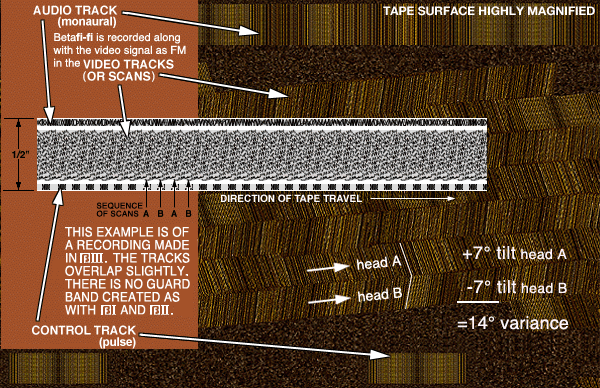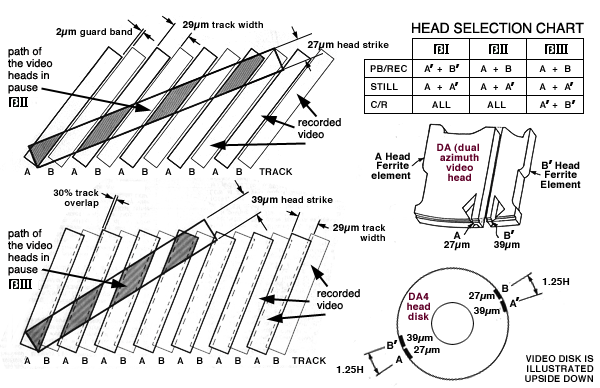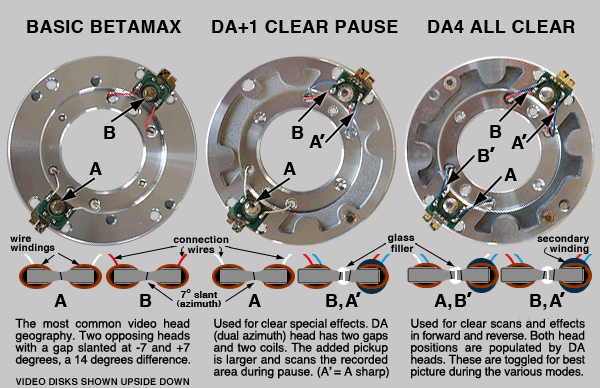|
Single gap and dual azimuth (DA) gap are terms used to describe the two types of video heads used in Beta video recorders. The single gap head type has one opening in each inductive element that touches the tape, and the DA type has two. The second gap on one or both of the DA heads is used for reproducing special effects, such as a clear picture in pause, scanning, or during stepping. Sony featured DA heads in a number of their high-end models. The various types of video disk arrangements and head types are explained below. The video disk spins inside the video drum and it writes or reads a signal from a tape by touching it lightly. To accomplish this task the disk has tiny electromagnets located in precise locations. Heads are always 180 degrees opposite to each other. That way when it makes one rotation two signals are recorded. From this information the Beta VCR construct a visible picture.There were several designs used over the years but the format never changed. Here are the various used starting after the SL-5000 series Betamax. The disk on the left is the most common two-head design (all disks are shown upside down to reveal their head arrangement). It is used in most of the basic Beta VCRs, and it has two single-gap heads. They are labeled as A and B, and they both have recording gaps slanted at opposite angles of seven degrees, making the total slant (or tilt) of the recording difference between the two of fourteen degrees. This tilt angle is called the azimuth, and it allows the video tracks to record right next to each other without causing crosstalk or adjacent noise. Azimuth is the angle used and is not to be confused with the term when describing a dual azimuth (DA) video head(s). The DA head is of a special design that has two gaps (pickup locations) on one or two compound electromagnets. It is used to clean up the special effects by reading more signal. The extra gaps are not used during recording. Disks with DA heads are shown above in the center and on the right. The angle across their gap is slanted the same as their companion, but when two heads are used, they have matching angles on each side. This is done to grab still more signal off the tape. Check out the angles in the graphic above. This is done to maximize the strike area for creating a picture. The VCR makes sense of it all in what is called the jog processor. This is a dedicated circuit that knows when to switch to the correct head(s) for producing the best picture. Each has its own separate winding so they can be operated independently of each other. The pickup(s) used for special effects has a slightly larger metal surface than the standard, which also increases its reading area. The core widths are 27µm for the normal gap designated as A (for the standard normal Beta picture) and 39µm (µ is millionths of an inch) for the DA gap(s) portion of the compound head. It is labeled the A sharp (A'). They don't look that different, but you'll notice extra hookup wires for the added windings. The DA+1 disk configuration has one standard video head and one with a larger DA head. The DA4 disk has two dual azimuth heads, and it produces better performance than the DA+1 configuration (and also the basic two head single-azimuth arrangement). Below each disk is a drawing of the head design showing the gap locations and winding arrangement. The copper color is the wiring wound around the smaller ferrite iron core. The dual heads here have the additional winding shown as dark green. There is one more disk arrangement used in high-end Betas that you can see by clicking on the picture. This disk has flying erase heads that are used for erasing individual video scans when making video inserts. The recording and playback heads are still the dual azimuth type. Why DA heads are used and how they benefit the VCR is discussed next. Scroll down to see the next graphic.  This is a greatly magnified picture of the magnetized surface of a recorded videotape. The picture details have been standardized and sharpened to show detail. The normal audio track is seen recorded along the top edge, and the control track pulse that starts each frame of the picture is along the bottom. The scans of the spinning video heads (A and B) are recorded between these two linear tracks. You will notice that as the tape travels through the path (and around the video drum), the video heads record a tilted (elongated) track. This slanted recording method is called longitudinal scanning, and it provides the writing length and high speed necessary for video recording. Recording video requires a lot of area and a fast recording speed to capture the high frequencies require for video. Notice that the A and B tracks are right next to each other in this slowest (  ) speed. The head azimuth (gap angle) permits each of these two tracks to slightly overlap without disturbing the adjacent scan. The 7-degree angle of each head prevents them from picking up the opposite scan because there is a 14 degrees total variance between them. This difference cannot be read by the adjacent head as it passes. Move down to the next drawing. ) speed. The head azimuth (gap angle) permits each of these two tracks to slightly overlap without disturbing the adjacent scan. The 7-degree angle of each head prevents them from picking up the opposite scan because there is a 14 degrees total variance between them. This difference cannot be read by the adjacent head as it passes. Move down to the next drawing. Note: The track angles for this example are shortened and enlarged for simplicity. During recording and playback, the two single-gap video head system works great. It even has the reputation of having a slightly longer life because of the simpler, less delicate design. And they will even reproduce a viewable picture in still pause and Step-motion, but it will have some noise lines in it. This is because the spinning heads can't pick up the complete scan. The recording was made as the tape was moving. When it is sitting stationary, the scan angles don't match. To correct this discrepancy, additional heads are needed to help get more information for building a more complete picture. Dual azimuth heads (dual electromagnetes) are used to grab more signal and construct a better viewing experience. Here is how the system operates. Reference the graphic above. During recording, the same two heads are used for  and and  speeds. (DA4 machines that record in speeds. (DA4 machines that record in  s use the A' and B' heads for this speed.) The width of each angled head is 27µm (27 millionths of an inch). During the slowest speed of ( s use the A' and B' heads for this speed.) The width of each angled head is 27µm (27 millionths of an inch). During the slowest speed of ( ) the tracks are actually overlapping 30%, which doesn't cause a problem due to the azimuth (angle) of the recording gap. Also, this slow speed creates a large carpet of signal area, which makes pause and Betascan video fairly clear. But in ) the tracks are actually overlapping 30%, which doesn't cause a problem due to the azimuth (angle) of the recording gap. Also, this slow speed creates a large carpet of signal area, which makes pause and Betascan video fairly clear. But in  the situation is a little different. You can see that recording with the 27µm video head at this speed creates a 2µm band of unrecorded area, known in tech-speak as a guard band. This area is blank, and it isolates one track from the other, so there is no signal overlap. This guard band is desirable and makes for a cleaner recording because there is less opportunity for side-by-side interference. But it creates a problem in pause, Step-motion, BetaScan (cue and review), and BetaSkipscan. These empty areas create noise lines in the picture due to the lack of information. As mentioned earlier, the tape is moving during recording, so when it is stationary the heads are scanning over several tracks at a time. In the situation is a little different. You can see that recording with the 27µm video head at this speed creates a 2µm band of unrecorded area, known in tech-speak as a guard band. This area is blank, and it isolates one track from the other, so there is no signal overlap. This guard band is desirable and makes for a cleaner recording because there is less opportunity for side-by-side interference. But it creates a problem in pause, Step-motion, BetaScan (cue and review), and BetaSkipscan. These empty areas create noise lines in the picture due to the lack of information. As mentioned earlier, the tape is moving during recording, so when it is stationary the heads are scanning over several tracks at a time. In  they also cross over those blank areas. This generates noise lines. To the rescue comes the DA head(s). They scan more area over several tracks. The secondary heads are, by design, very slightly behind the primary heads, which are also used to collect signal. Three or four heads altogether, depending on the feature or design requirements. All this information fills in the lines and helps to build a clearer picture. Having two DA heads (DA4) does the same thing only better, plus they help out in Step-motion in forward and reverse and in BetaScan. In the above graphic, you can see a table showing how the dual DA heads are electronically selected for the different speeds (shown is for the SL-HF900; others are similar) and how the head ferrite core is constructed. Below are the models that have the DA heads. All are Sony unless otherwise noted. Any models not listed have the disk with two single gap heads. they also cross over those blank areas. This generates noise lines. To the rescue comes the DA head(s). They scan more area over several tracks. The secondary heads are, by design, very slightly behind the primary heads, which are also used to collect signal. Three or four heads altogether, depending on the feature or design requirements. All this information fills in the lines and helps to build a clearer picture. Having two DA heads (DA4) does the same thing only better, plus they help out in Step-motion in forward and reverse and in BetaScan. In the above graphic, you can see a table showing how the dual DA heads are electronically selected for the different speeds (shown is for the SL-HF900; others are similar) and how the head ferrite core is constructed. Below are the models that have the DA heads. All are Sony unless otherwise noted. Any models not listed have the disk with two single gap heads.
|
Betas VCRs with DA+1 heads:
Betas VCRs with DA4 heads:
*These Betas also have flying erase heads. †Similar configuration as DA4 but switched differently.
Betas VCRs with DA4 heads:
Sony supplied DA disks to the other Betamakers but some chose tom use their own drum design for special effects. They used one or two extra heads for performing clear pause, step-motion, etc. These were operated similar to the dual azimuth heads and offered comparable performance. The main difference with using separate heads is the scanning locations are rotated 45 degrees and orchestrated by the effects circuitry. For more on multiple head playback click here. For more on azimuth recording click here.
©Misterßetamax
go to homepage |
